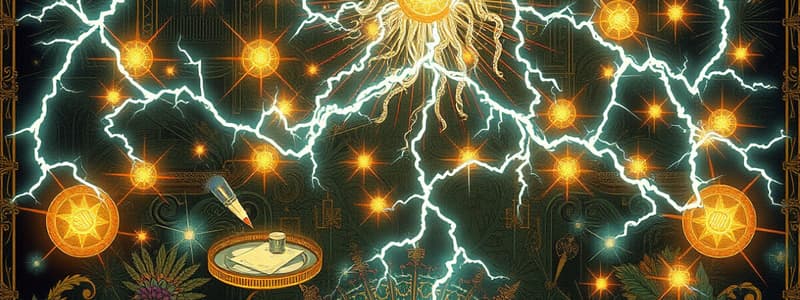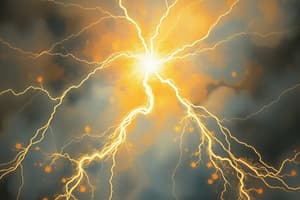Podcast
Questions and Answers
What is static electricity?
What is static electricity?
- Magnetic fields created by moving charges
- Friction produces electrical charge (correct)
- Electric charge at rest (correct)
- Electric current produced by batteries
How does an object become charged?
How does an object become charged?
By rubbing, it possesses a net electric charge.
What are the two kinds of charges?
What are the two kinds of charges?
Positive charge and negative charge.
What is the net charge if equal amounts of opposite charge are produced?
What is the net charge if equal amounts of opposite charge are produced?
What happens when charge is transferred between two objects?
What happens when charge is transferred between two objects?
How is an atom represented in terms of charge?
How is an atom represented in terms of charge?
Electrons are less massive than protons and neutrons.
Electrons are less massive than protons and neutrons.
What happens when an object is neutral?
What happens when an object is neutral?
What determines the structure, properties and function of matter?
What determines the structure, properties and function of matter?
Define an ion.
Define an ion.
What are conductors?
What are conductors?
What are insulators?
What are insulators?
How does conduction charge an object?
How does conduction charge an object?
What does an electroscope do?
What does an electroscope do?
How can charge be induced?
How can charge be induced?
What is the net charge on a conductor?
What is the net charge on a conductor?
What are free charges in a conductor?
What are free charges in a conductor?
What prevents the leaves of an electroscope from moving farther apart?
What prevents the leaves of an electroscope from moving farther apart?
What happens if the charge is doubled on one object?
What happens if the charge is doubled on one object?
What happens if the charges on both objects are doubled?
What happens if the charges on both objects are doubled?
What happens if the distance between charged objects is doubled?
What happens if the distance between charged objects is doubled?
What can be said about two repelling charged balls?
What can be said about two repelling charged balls?
What charge must a metal ball have if it is attracted to a positively charged rod?
What charge must a metal ball have if it is attracted to a positively charged rod?
What happens when two neutral conductors are connected by a wire and charged rod is brought near?
What happens when two neutral conductors are connected by a wire and charged rod is brought near?
According to Coulomb's law, what does force depend on?
According to Coulomb's law, what does force depend on?
What is the superposition principle?
What is the superposition principle?
Where should a charged ball be placed between two positively charged balls to get zero net force?
Where should a charged ball be placed between two positively charged balls to get zero net force?
Which particle has the largest acceleration when a proton and an electron are released?
Which particle has the largest acceleration when a proton and an electron are released?
What happens when moving farther away from a positive charge?
What happens when moving farther away from a positive charge?
What is called action at a distance?
What is called action at a distance?
What do we call +Q?
What do we call +Q?
What do we call -Q?
What do we call -Q?
What happens when Q interacts with an electric field?
What happens when Q interacts with an electric field?
What is the formula for electric force?
What is the formula for electric force?
What is line density in an electric field?
What is line density in an electric field?
Why can electric field lines never cross?
Why can electric field lines never cross?
What is an electric dipole?
What is an electric dipole?
What does the gravitational field do?
What does the gravitational field do?
What is electric flux?
What is electric flux?
What is the electric flux formula for uniform fields?
What is the electric flux formula for uniform fields?
What determines the number of field lines in an electric field?
What determines the number of field lines in an electric field?
What are characteristics of conductors in electrostatic equilibrium?
What are characteristics of conductors in electrostatic equilibrium?
Study Notes
Electric Charge Fundamentals
- Static Electricity: Produced via friction, resulting in electric charge; requires electric force to cause motion.
- Charging Mechanism: Objects gain charge through rubbing, resulting in a net electric charge.
- Types of Charges: Identified as positive and negative; unlike charges attract while like charges repel.
- Charge Conservation: When one object gains charge, another loses an equal amount, maintaining a net charge of zero.
Atomic Structure and Charge
- Atom Representation: Defined by atomic number (protons) and atomic mass (protons + neutrons).
- Charge Neutrality: An object is neutral when it has equal amounts of protons and electrons.
- Ion Formation: Atoms become ions by losing or gaining electrons, resulting in a net positive or negative charge.
Conductors vs. Insulators
- Conductors: Metals like gold and silver allow free movement of charge; electrons are loosely bound to nuclei.
- Insulators: Such as water, have tightly bound electrons and do not conduct electricity.
- Charge Transfer: Friction can separate charges; when two materials are rubbed, charge can be transferred.
Methods of Charging
- Conduction: Involves direct contact between charged and neutral objects, resulting in both acquiring the same charge.
- Induction: A charged object induces a charge separation in a neutral object without direct contact, leading to polarization.
Electric Forces and Fields
- Coulomb’s Law: The force between charges depends on the product of their magnitudes and the distance between them; doubling one charge doubles the force, while doubling both charges quadruples the force.
- Electric Field Direction: From positive to negative charges; does not overlap, signifying that no two forces can act at the same point.
Electric Field Characteristics
- Electric Flux: A measure of electric field intensity across an area, proportional to the number of field lines penetrating a surface.
- Electrostatic Equilibrium: Inside a conductor, the electric field is zero; excess charge resides on the surface, and field lines are perpendicular to the surface.
Forces and Particle Behavior
- Particle Acceleration: The electron experiences a greater acceleration than the proton when both are subjected to the same force due to its lower mass.
- Repelling Charges: If two charged objects repel each other, they must be of the same type (both positive or both negative).
Gauss's Law and Shielding
- Gauss's Law: Relates the electric field and charge enclosed within a closed surface; the number of electric field lines corresponds to the net charge.
- Electrostatic Shielding: The principle stating that the electric field inside a conductor is zero when in electrostatic equilibrium.
Overall Concepts
- Action at a Distance: Electric forces can act over a distance without contact.
- Field Representation: Electric field lines illustrate the direction of force on a positive test charge; they cannot intersect due to unique directionality at each point.
- Electrical Induction: Charging can occur by inducing a charge to move within an object without direct contact, allowing for temporary polarization effects.
By understanding these core concepts, students can grasp the principles governing electric charges and fields.
Studying That Suits You
Use AI to generate personalized quizzes and flashcards to suit your learning preferences.
Description
Test your understanding of static electricity and electric charges with these flashcards. This quiz covers key concepts such as how objects become charged and the two types of charges. Perfect for students studying electric fields in physics.




